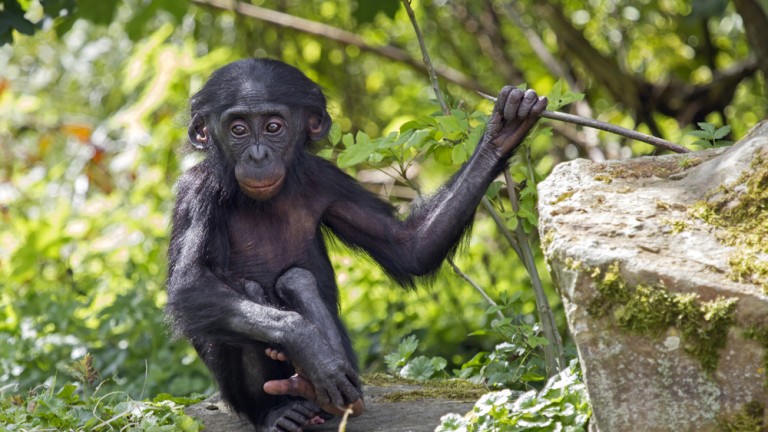Some of our most closely related relatives are facing extinction in the Congo Basin. They are among the most intelligent creatures in the animal kingdom, we share 98.7% of our DNA with them, they are sometimes called pygmy chimpanzees and less often, the dwarf or gracile chimpanzee, their scientific name is Pan Paniscus but their most common name is the Bonobo. They are smaller than the chimps and have a darker pigmentation around there face. They are typically more docile and the leader is usually female.
There only habitat is the Congo River Basin in Africa. The Congo Basin is one of the most important wilderness areas left on Earth. At 500 million acres, it is larger than the state of Alaska and stands as the world’s second-largest tropical forest. Only some of the Bonobo’s habitat is in a protected wilderness area making them vulnerable to poaching. Specific bonobo body parts are believed to enhance sexual vigor or strength. They are also killed and trapped to use them as bushmeat, keep them as pets and for use in traditional medicine.
One of the differences between the Bonobo and its Chimpanzee cousins are their behavioral patterns. Chimp troupes are typically led by a dominate male that would mate with the majority of the females (Did you know that a female chimp is called an empress?) and this can provoke violence and competition within a troupe. A Bonobo troupe is led by a female, and a pair will usually mate for life making for a more docile community. Although they are friendly to each other they can be very violent to their rivals.
As previously stated this species is on the endangered list. Scientists and biologists can’t accurately predict the overall population due to the remoteness of their habitat and the rising contentions in the Democratic Republic of Congo. It has been estimated that their population is around 10,000 to 50,000 and has been dwindling for the past 30 years and is forecasted to decline for 45 to 55 more. An organization named WWF is actively trying to save the reaming population in the Congo. They have given better training and equipment to anti-poaching units to protect the population that lives outside the reserve. WWF has provided training, equipment and field supplies for the non-governmental organizations that are conducting surveys of bonobo populations. A survey of large mammals in the DRC’s Lac Télé-Lac Tumba Landscape revealed a previously unknown population of bonobos, a population that has the highest density and largest group size of the animals anywhere in their range. After this discovery, WWF helped to establish the Lac Tumba-Lediima Nature Reserve, which will help to protect this dwindling species.
The Bonobo is a very special animal and should be recognized by the world. They are our closest living relatives by sharing 98.7% of their DNA with us and their cousins the chimps. These species are more docile with their family and troupe than the chimps who continually have conflict. You can help support the Bonobo by visiting the WWF website.
Citations
Bonobo.” WWF. World Wildlife Fund, n.d. Web. 13 Apr. 2017.
“Research Maniacs Directory | Follow | Search .” What Is a Female Chimpanzee Called? N.p., n.d. Web. 13 Apr. 2017.
“Chimp Facts, Articles, Recommended Reading.” Save the Chimps. N.p., n.d. Web. 13 Apr. 2017.
